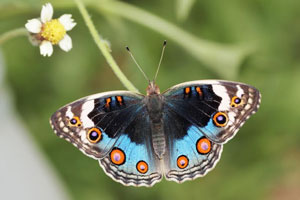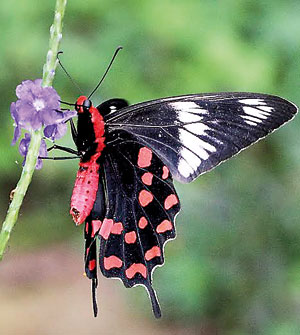Butterflies in the limelight
View(s):
Blue Pansy
The Lepidoptera (butterflies and moths) are one of just two orders of animals that are strictly protected in their entirety under Sri Lanka’s Fauna and Flora Protection Ordinance. It is illegal to kill, capture or have in your possession even a single insect, a rule that extends (albeit in the breach) even to the agricultural pests among them. Everyone loves butterflies: caterpillars, well, maybe not so much.
No surprise then that Sri Lanka’s butterflies have been celebrated not only in academic tomes from at least as far back as 1779, but also in rhyme and legend. Even the country’s best-known landmark is arguably named for these wonderful insects, and conservationists justly fret that the populations of most butterfly species are on the decline.
Serious research on the butterflies and moths of the island began with the arrival in Ceylon of Robert Templeton, who between 1839 and 1852 collected and exported almost 1,000 specimens to specialists overseas. He was followed by two people who together did for the butterflies what W.V. Legge had (in 1880) just done for the birds. The first was William de Alwis Seneviratne, who from 1865-1902 was an artist attached to the Royal Botanic Gardens, Peradeniya. In an astonishing feat even by today’s standards, Alwis illustrated in a series of splendidly detailed watercolours not only a total of some 350 Sri Lankan species, but for 250 of them, also the larva, pupa and food plant. It was upon these drawings that the British entomologist Frederic Moore came to base his massive ‘The Lepidoptera of Ceylon’ (1880-87; 3 volumes, 964 pages, 215 hand-coloured plates).
The 20th century also saw the publication of a number of popular books on butterflies, including those of Walter Ormiston (1924), Lionel Woodhouse & George Henry (1942), and Bernard d’Abrera (1998). Now, at last, comes a work that is completely different, from the husband and wife team of Michael and Nancy van der Poorten, whose new book, ‘The butterfly fauna of Sri Lanka’ will be released at a public launch at the auditorium of the Department of Meteorology on Bauddhaloka Mawatha at 6 p.m. on June 2.
Unlike their predecessors just named, the van der Poortens have photographed in life pretty much every species of butterfly there is in Sri Lanka. The 418-page book (a hefty 1.5 kg!) contains upwards of 2,000 (yes, two thousand) beautiful colour photographs of live butterflies in their various stages: egg, larva, chrysalis, adult. And that is not counting the hundreds of photos of insect associations, larval food plants, nectaring plants and habitats. But there’s more. The van der Poortens’ text includes information on how to distinguish each species from others that resemble it, distribution, habitat, immature stages and behaviour. Overall, the coverage is nothing short of encyclopaedic.
The price paid for all this information and illustration, however, is that the text is somewhat closely set and the illustrations relatively small. Then again, it is perfectly easy to read, and the depictions of the individual butterflies usually comparable to life-size and big enough to see what needs to be seen. All in all, the book is elegantly and professionally laid out, and the quality of paper, printing and binding (the book was produced in Canada) world-class.
| Book facts: ‘The butterfly fauna of Sri Lanka’, by Michael & Nancy van der Poorten. Reviewed by Rohan Pethiyagoda |

Crimson Rose
The van der Poortens have invested almost two decades of their lives in this labour of love, not only travelling the length and breadth of the island in search of elusive butterflies but also breeding many of the species in the garden of their coconut-estate near Wariyapola. ‘The butterfly fauna of Sri Lanka’ has no parallel in the zoological literature of Sri Lanka: so comprehensive is it. It is a model for ‘faunas’ on other groups of animals and one hopes the day is not far off when books of similar scope will appear also on important animal groups such as birds, reptiles, amphibians and fish. What shines through is the authors’ reliance on information and imagery acquired first-hand rather than from secondary sources: they write from personal knowledge, not books.
The pre-publication price of Rs 6,200 (applicable to the launch only) is a substantial discount on the eye-watering Rs 9,000 the volume will cost at bookshops thereafter. There can be no doubt this will soon become not only the standard text on Sri Lanka’s butterflies, but a highly desirable collectors’ item. Buy it while you can!


